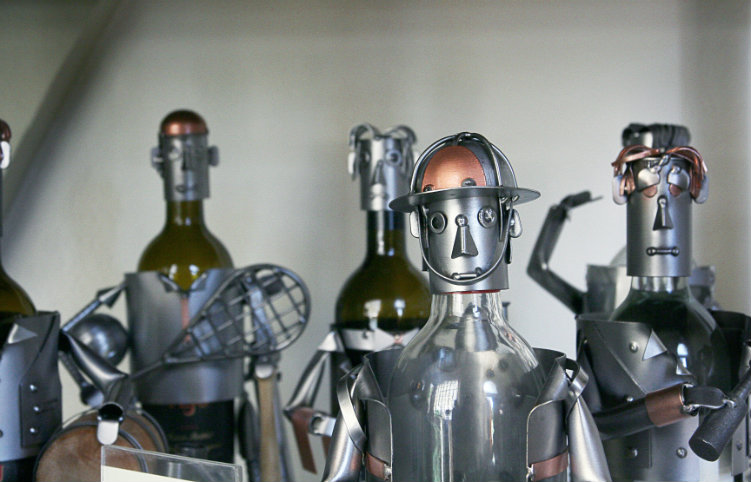Book Review | Padraig Kenny’s Tin
Padraig Kenny’s children’s novel, Tin, opens with an engineer, Mr Absalom, crunching through snow with a human boy, Christopher, and a robot child for sale, Jack. Absalom swaps Jack’s red hair for brown, ‘because nobody buys gingers, awful sickly-looking things.’, and tells Jack to stick to the routine. They come to a house that is opened by a dazed-looking man, Mr Chapman. We gradually realise what’s happening. Absalom is taking advantage of this individual, a man who is grieving the loss of a child. However, the vulnerable father comes to his senses when Absalom takes the sales pitch too far, and Jack is instead hurtled across the home’s snowy front lawn. The scene is a swift gut punch, one that foreshadows the simmering emotion that runs through the story.
Pádraig Kenny’s debut novel feels like it could have been concocted by the classic robot-aficionado, Isaac Asimov, which is no meagre comparison. Asimov is credited for introducing the word “robotics” to the English language, and his “Three Laws of Robotics” (introduced in a 1942 short story) began a discussion of robot ethics that has become increasingly important with the growing sophistication of A.I. Kenny is following in Asimov’s footsteps when he opens his novel with the introduction of his world’s four “Laws of Mechanics”. However, these laws are quite different from Asimov’s, which focused on robot obedience. Kenny’s laws focus on something more metaphysical: forbidding sentience in robots.
These laws are the source of much of the conflict in the novel, as Christopher suddenly discovers that he is not a “real boy” but a sentient robot. Shortly after this discovery, Christopher is abducted by people who appear to be government agents, led by the villainous engineer, Richard Blake. Blake proceeds to interrogate Christopher, trying to uncover which of the robot’s memories are real. Left behind with a disenfranchised Mr Absalom, Jack—along with a group of robotic children—decide they must rescue Chris. From here on, the narrative divides between Christopher’s and Jack’s perspectives.

Tin has further parallels with Asimov’s robot stories in portraying robots as vulnerable. One character discusses a time where there were no laws governing how humans treated their robots:
“They used to dump the old ones by the side of the road. Discards would just wander around until somebody either picked them up and used them or had them smelted down.”
Since the introduction of the laws, things seem to have improved somewhat for robots, but they’re still belittled. Absalom only sees his robots as objects to sell, and in London, robots are primarily used for menial work: driving their owners around the city, reading people newspapers, running fruit stalls. In addition to this, there is one moment when a robot is emotionally and physically abused, treated more like an object than a sentient being.
Robots’ appearances and functionality are dictated entirely by engineers in the world of the novel. Mandy and Rob, both part of Jack’s group, have physical limitations: Mandy stumbles and constantly falls because of her mismatched legs, and Rob’s head regularly tumbles off. Many robots flock to Ironhaven, a town surrounded by trees with tinplate bark and copperplate leaves. They hope to be repaired by the engineer and robot-sympathiser, Mr Cormier. They crowd outside his gates, building ‘sharp and angular’ metallic homes, camping out in the hope of having their bodies mended.
Despite these hardships, the mood of Tin is rarely hopeless or dark. The main robot characters are lovable and distinctive. While Jack is the leading robot voice of the book, it is the quirky Round Rob who is the stand-out character. His torso is built with a cooking pot that allows him to roll down hills, his eyebrows are continually falling off, and he shares loud fits of laughter with the typically stern Mr Cormier. Nothing seems to faze Rob for long. He has a pure constant drive just to do good and not to give up. It’s difficult not to smile when he’s on the page.

The novel’s events take place in a Britain that has recently been involved in an unspecified war. During his interrogation of Christopher, Richard Blake often talks about the lives that could have been saved if Britain had used the war machine his father helped to construct: “Mechanicals created for the purpose of war would not only have saved lives but would have made this nation great again.” It’s a terrifying speech, partially because the end of it echoes Trump’s slogan, “Make America Great Again.” However, we never know whether Britain is truly deteriorating or whether this is in Blake’s unhinged imagination. Kenny rarely delves into the background, leaving just enough for speculation.
There are some periods in the midpoint of the novel where I felt my attention waning. The pace slows down too much and some of the plot twists are predictable. There were also a few moments when I felt as though the reader was supposed to care or feel sympathy for certain side characters, but I only felt disinterest. However, the steady progression of the main plot kept me intrigued enough to persevere through the dips and reach the fantastic finale.
Blake, who is holding Christopher captive, begins to remove the sentient robot’s memories, hoping to uncover something unknown to us. The emotion-filled images of the past disappear before Christopher’s eyes, and Kenny sketches his reaction beautifully. As the novel begins to wind down, we learn more about the engineers, Blake and Cormier, understanding their complex motivations and internal struggles.
The closing chapters are tense, full of twists, and the ending is touching, finishing at just the right point. The book digs down to the question of what it is to be human. It is reminiscent of Phillip Pullman’s His Dark Materials in its refusal to patronise the reader. Wonderfully hopeful, Tin is a must-read for children and optimistic robot fans.

